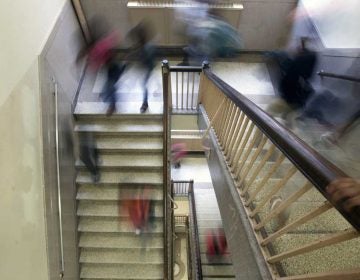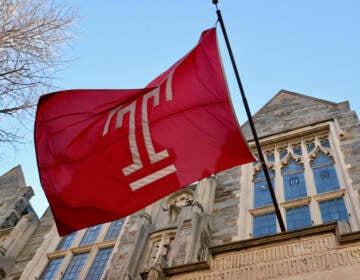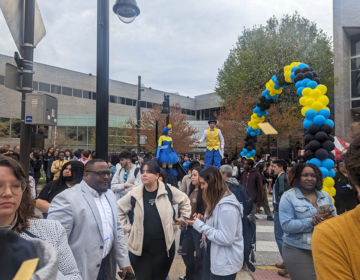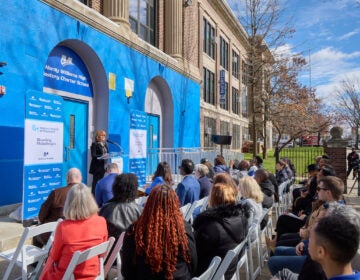Principals, district officials clash over new Philly schools budget
The overall budget increased for Philly’s public schools. But some principals say their schools have been shortchanged.

File photo: Empty hallways at E. W. Rhodes Elementary School in Philadelphia. (Kimberly Paynter/WHYY)
The School District of Philadelphia has unveiled its proposed $3.9 billion budget for the next school year — a proposal the principals’ union is calling a “massacre” but district officials insist will put more resources into many classrooms.
“The current [school] year, we have a record number of supports for students,” said Uri Monson, the district’s chief financial officer, as he presented the budget at a school board meeting Thursday night. “The proposed budget is an increase of $170 million in district-operated schools, despite continued enrollment loss over the current year.”
But some school principals and administrators say the new budget will lead to staffing cuts at their schools, at a crucial time when students are trying to regain ground lost during the pandemic.
“There should never be a day when a principal has to beg for money to provide the bare minimum for students to achieve,” Julian Graham, an assistant principal at Bartram High School, told the board. “Stop treating education as a business and treat it as a birthright.”
He said that in a city with rising violence, where students have been exposed to high levels of trauma, “the individuals that lose out are not the educators being cut from budgets but the students who have built bonds with teachers, assistant principals, and climate managers who support their social-emotional needs [and] academic welfare.”
Monson touted the impact an additional $170 million would make for many schools, from the best staff-to-student ratio in a decade to more special education and ESL teachers. The district would average one teacher for every 12.3 students, compared to 13.3 in 2011; with counselors and other staff members factored in, the ratio drops to one adult for every 6.6 students, compared to 7.4
The proposed budget pays for extra hours for school climate staff and more before- and after-school programs. Student-counselor ratios would drop, and the district would hire more bilingual counseling assistants, to help families navigate the school system.
But because of the district’s enrollment projections, and a change in the way it distributes federal pandemic relief funds, some schools will lose multiple staff positions — a move that’s led to strong pushback from educators.
“I can navigate the district website and find all of the language that espouses that we are committed to equity,” Cassidy principal Tangela McClam told board members. “However, when we see cookie-cutter budgets that are based on pure numbers and not getting students what they need, one must question how it aligns with our language.”
She said the district added one or two positions to each school last year, “yet they were snatched away, not just from our budgets but from our children. These snatches have created a cycle that nearly ensures that our schools fail.”
An enrollment surprise
Monson said the staffing cuts are connected to enrollment declines.
The district is losing about 4,000 students a year, including children who left for cyber charters during the pandemic. Monson said officials expected some of them to return last year, once school buildings reopened, but the reverse happened and “the cyber population went up.”
He also said enrollment drops will seem more dramatic this year because the district temporarily paused a process called leveling, where schools lose or gain teachers several months into the year based on discrepancies between actual student enrollment and projections. The district held off on leveling last year, but will restart the practice this year.
“What you’re seeing is actually almost two years’ worth of enrollment loss hitting in one year in the schools,” he said.
If more students return to the district, and enrollment numbers go up, Monson stressed that the district will add resources and “adjust the allocation immediately.”
But many administrators have taken issue with the current projections, according to a survey from the Commonwealth Association of School Administrators (CASA), the union representing Philadelphia principals.
At a virtual town hall meeting on Monday, the group said it worries about the district cutting key positions.
Principals who responded to the survey said their schools are losing an average of five teachers in the new budget. 73 percent will have to cut school climate managers, 63 percent will lose literacy and math specialists, 73 percent will not be able to fund a special education compliance monitor, and 43 percent will lose assistant principals.
Referencing the projected enrollment declines, Penn Alexander principal Lauren Overton told the board that “taking resources away from our schools will not bring those students back.”
These cuts are also driven by changes to how the district allocates federal relief funds, in response to concerns that those funds were not being distributed equitably, Monson said. He noted that smaller schools received more money, per-pupil, than larger ones.
“A position that goes to a school with 300 students is a very high per-pupil investment, whereas the same one position for a school with 3,000 students is very small,” he said. “When we did the analysis … the highest per-pupil versus the lowest per-pupil was actually a $1,900 gap.”
Last year, schools that the district considers “on-track” – that is, meeting academic standards – received funding for one additional position. Those deemed “off-track” got money for two positions. This year, on-track schools will receive money to use however they want, with the amount based on school size and poverty level. Off-track schools will receive funding for one additional position.
“Not an inevitable … situation”
But at a rally outside the school board meeting, and throughout the public comment section, school leaders and education advocates said no schools should lose money – and critical staff – at the very moment students need extra academic and emotional support.
City Councilmember Helen Gym asked the board not to accept the projected loss of 7,000 students, and to pursue an “aggressive re-engagement strategy” to bring students back into the district.
“This is not an inevitable or passive situation,” she said.
The district has long had a structural imbalance – with costs rising faster than revenues. But in the near future, federal relief dollars have covered up that hole and left the district in a relatively rosy financial position.
In a five-year projection released Thursday, the district forecasted that it would end the upcoming fiscal year with a fund balance over half a billion dollars. But that total is subject to change as state and local leaders make their own budget decisions.
Monson stressed that adopting the “lump sum” budget is the start of an evolving process. The school board will vote on a final budget on May 26.
WHYY is your source for fact-based, in-depth journalism and information. As a nonprofit organization, we rely on financial support from readers like you. Please give today.










